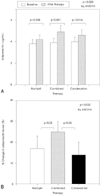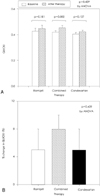Abstract
Background and Objectives
Ramipril and candesartan have decreased the incidence of new onset diabetes in large scale randomized clinical studies. Because ramipril and candesartan have distinct mechanisms of action in the renin angiotensin aldosterone system, we hypothesized that combination therapy would have additive beneficial metabolic effects in patients with hypertension.
Subjects and Methods
Thirty-four patients were given ramipril 10 mg and placebo, ramipril 10 mg and candesartan 16 mg, or candesartan 16 mg and placebo daily in a randomized, double-blind, placebo-controlled cross-over trial with three treatment arms and two washout periods (each being 2 months).
Results
Ramipril, combination therapy or candesartan significantly increased the plasma adiponectin levels relative to the baseline measurements by 17±6% (p=0.038), 25±5% (p<0.001), and 14±6% (p=0.016), respectively. Combination therapy significantly increased the plasma adiponectin levels more than either ramipril or candesartan alone (p=0.020 by ANOVA). Only combination therapy significantly increased the QUICKI level relative to the baseline measurements (p=0.002). There were no significant correlations between these changes of the metabolic parameters and reduction of the systolic blood pressure (-0.288≤r≤0.284) and reduction of the diastolic blood pressure (-0.282≤r≤0.190). On multivariate analysis, only the change of adiponectin levels was an independent predictor of the changes in the QUICKI levels (β=1.549, p=0.040) following combination therapy.
Conclusion
Ramipril in combination with candesartan increases the plasma adiponectin levels to a greater extent than monotherapy with either drug alone. Only combination therapy significantly improves insulin sensitivity relative to the baseline measurements. The only predictor for the improvement of insulin sensitivity is the increase of plasma adiponectin levels by combination therapy.
Figures and Tables
 | Fig. 1The study design. This study was randomized, double-blind, placebo-controlled, with three treatment arms (each 2 months), and crossover with two washout periods (each 2 months). B1: baseline 1, B2: baseline2, B3: baseline 3. |
 | Fig. 2The effects of ramipril alone, combined therapy and candesartan alone on plasma adiponectin. A: ramipril, combination therapy, or candesartan significantly increased plasma adiponectin levels relative to baseline measurements (p=0.038, p<0.001, p=0.016, respectively). B: combination therapy significantly increased plasma adiponectin levels more than either ramipril or candesartan alone (p=0.020 by ANOVA). ANOVA: analysis of variance. Vertical line indicates standard error of mean from the respective baseline. |
 | Fig. 3The effects of ramipril alone, combined therapy and candesartan alone on QUICKI. A: only combination therapy significantly increased QUICKI relative to baseline measurements (p=0.002). B: there were no significant differences of percent changes in QUICK among 3 groups. QUICKI: quantitative Insulin-Sensitivity Check Index. Vertical line indicates standard error of mean from the respective baseline. |
Table 1
Effects of ramipril, combined therapy, and candesartan in hypertensive patients

Data are expressed as means±SEM. There were no significant differences among each baseline values. *: p<0.05, †: p<0.01, ‡: p<0.001 for comparison with each baseline value. BP: blood pressure, FMD: flow mediated dilation, NTG: nitroglycerin, quantitative insulin-sensitivity check index (QUICKI)=1/[log (insulin)+log (glucose)], ANOVA: analysis of variance, R/C: ramipril vs combined therapy, R/A: ramipril vs candesartan, C/A: combined therapy vs candesartan, NS: not significant
References
1. Han SH, Quon MJ, Koh KK. Reciprocal relationships between abnormal metabolic parameters and endothelial dysfunction. Curr Opin Lipidol. 2007. 18:58–65.
2. Song JS, Kim YS, Cheong HJ, et al. Antihypertensive effect of ramipril in patients with essential hypertension. Korean Circ J. 1993. 23:597–602.
3. Kang SM, Chung NS, Choi DH, et al. A clinical study on anti-hypertensive effect and safety of candesartan cilexetil (Atacand®) in mild to moderate hypertensive patients. Korean Circ J. 1999. 29:937–943.
4. Yusuf S, Sleight P, Pogue J, Bosch J, Davies R, Dagenais G. Effects of an angiotensin-converting-enzyme inhibitor, ramipril, on cardiovascular events in high-risk patients. N Engl J Med. 2000. 342:145–153.
5. Demers C, McMurray JJ, Swedberg K, et al. Impact of candesartan on nonfatal myocardial infarction and cardiovascular death in patients with heart failure. JAMA. 2005. 294:1794–1798.
6. Bosch J, Lonn E, Pogue J, Arnold JM, Dagenais GR, Yusuf S. Long-term effects of ramipril on cardiovascular events and on diabetes: results of the HOPE study extension. Circulation. 2005. 112:1339–1346.
7. Yusuf S, Ostergren JB, Gerstein HC, et al. Effects of candesartan on the development of a new diagnosis of diabetes mellitus in patients with heart failure. Circulation. 2005. 112:48–53.
8. Nolan JJ, Ludvik B, Beerdsen P, Joyce M, Olefsky J. Improvement in glucose tolerance and insulin resistance in obese subjects treated with troglitazone. N Engl J Med. 1994. 331:1188–1193.
9. Han SH, Quon MJ, Kim JA, Koh KK. Adiponectin and cardiovascular disease: response to therapeutic interventions. J Am Coll Cardiol. 2007. 49:531–538.
10. Iwashima Y, Katsuya T, Ishikawa K, et al. Hypoadiponectinemia is an independent risk factor for hypertension. Hypertension. 2004. 43:1318–1323.
11. Hotta K, Funahashi T, Arita Y, et al. Plasma concentrations of a novel, adipose-specific protein, adiponectin, in type 2 diabetic patients. Arterioscler Thromb Vasc Biol. 2000. 20:1595–1599.
12. Kumada M, Kihara S, Sumitsuji S, et al. Coronary artery disease. Association of hypoadiponectinemia with coronary artery disease in men. Arterioscler Thromb Vasc Biol. 2003. 23:85–89.
13. Koh KK, Quon MJ, Han SH, et al. Vascular and metabolic effects of combined therapy with ramipril and simvastatin in patients with type 2 diabetes. Hypertension. 2005. 45:1088–1093.
14. Koh KK, Quon MJ, Han SH, Chung WJ, Lee Y, Shin EK. Anti-inflammatory and metabolic effects of candesartan in hypertensive patients. Int J Cardiol. 2006. 108:96–100.
15. Kim KB. The role of angiotensin receptor antagonist in patients with hypertension and cardiovascular diseases. Korean Circ J. 1999. 29:335–340.
16. Katz A, Nambi SS, Mather K, et al. Quantitative insulin sensitivity check index: a simple, accurate method for assessing insulin sensitivity in humans. J Clin Endocrinol Metab. 2000. 85:2402–2410.
17. Gokce N, Holbrook M, Hunter LM, et al. Acute effects of vasoactive drug treatment on brachial artery reactivity. J Am Coll Cardiol. 2002. 40:761–765.
18. Coretti MC, Anderson TJ, Benjamin EJ, et al. Guidelines for the ultrasound assessment of endothelial-dependent flow-mediated vasodilation of the brachial artery. J Am Coll Cardiol. 2002. 39:257–265.
19. Lakkis J, Lu WX, Weir MR. RAAS escape: a real clinical entity that may be important in the progression of cardiovascular and renal disease. Curr Hypertens Rep. 2003. 5:408–417.
20. Taal MW, Brenner BM. Renoprotective benefits of RAS inhibition: from ACEI to angiotensin II antagonists. Kidney Int. 2000. 57:1803–1817.
21. Komine N, Khang S, Wead LM, Blantz RC, Gabbai FB. Effect of combining an ACE inhibitor and an angiotensin II receptor blocker on plasma and kidney tissure angiotensin II levels. Am J Kidney Dis. 2002. 39:159–164.
22. Pfeffer MA, McMurray JJ, Velazquez EJ, et al. Valsartan, captopril, or both in myocardial infarction complicated by heart failure, left ventricular dysfunction, or both. N Engl J Med. 2003. 349:1893–1906.
23. Demers C, McMurray JJ, Swedberg K, et al. Impact of candesartan on nonfatal myocardial infarction and cardiovascular death in patients with heart failure. JAMA. 2005. 294:1794–1798.
24. Nakao N, Yoshimura A, Morita H, Takada M, Kayano T, Ideura T. Combination treatment of angiotensin-II receptor blocker and angiotensin-converting-enzyme inhibitor in non-diabetic renal disease (COOPERATE): a randomised controlled trial. Lancet. 2003. 361:117–124.
25. Teo K, Yusuf S, Sleight P, et al. Rationale, design, and baseline characteristics of 2 large, simple, randomized trials evaluating telmisartan, ramipril, and their combination in high-risk patients: the Ongoing Telmisartan Alone and in Combination with Ramipril Global Endpoint Trial/Telmisartan Randomized Assessment Study in ACE Intolerant Subjects with Cardiovascular Disease (ONTARGET/TRANSCEND) trials. Am Heart J. 2004. 148:52–61.
26. Sharma AM, Janke J, Gorzelniak K, Engeli S, Luft FC. Angiotensin blockade prevents type 2 diabetes by formation of fat cells. Hypertension. 2002. 40:609–611.
27. Schupp M, Janke J, Clasen R, Unger T, Kintscher U. Angiotensin type 1 receptor blockers induce peroxisome proliferators-activated receptor-activity. Circulaton. 2004. 109:2054–2057.




 PDF
PDF ePub
ePub Citation
Citation Print
Print


 XML Download
XML Download